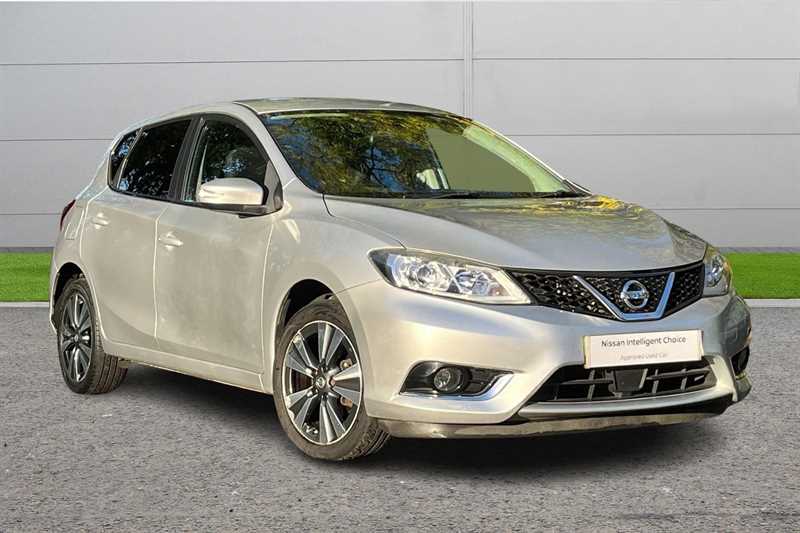Click for vehicles with £200-£700 cashback + free delivery
- Monday-Friday, 9am-5pm
- 020 3936 1257
- hey@heycar.co.uk
See what customers are saying
“Excellent”
Trustscore: 4.4/5
Copyright 2024 heycar - All rights reserved
Click for vehicles with £200-£700 cashback + free delivery

£8,995

£5,903
was
£9,795
£1,000 offWhen Nissan launched the Juke and the Qashqai, both models immediately outsold the old Almera and Primera that they had effectively replaced. So it was strange when Nissan then brought the Pulsar to the UK market: a fairly bland hatchback of the sort it had never had much success with in the past.
A short sales run from 2014 to 2018 probably tells you all you need to know about how that worked out, while the Juke and Qashqai are still selling well. But the Pulsar did at least offer a small number of buyers a spacious and comfortable hatch for a reasonable price, and that’s the case with used versions today too.
The Nissan Qashqai family SUV is the obvious alternative to the Pulsar, but so are regular, and more talented family hatchbacks such as the Ford Focus, Volkswagen Golf, Renault Megane, Peugeot 308, and Korean models like the Hyundai i30 and Kia Ceed.
It would possibly be unfair to simply write “no” in this section and leave it at that. The Nissan Pulsar just isn’t the most interesting, inspiring, entertaining, or desirable car, lacking many of the qualities that make most of its contemporary rivals worth buying, and also other models from the Nissan family, notably the Qashqai family SUV.
But the Pulsar isn’t completely devoid of plus points, so in no particular order, these are them. It’s spacious, to a competitive level in the front seats and to a nearly class-leading level in the rear seats, and passenger volume hasn’t come at the expense of boot space either - 385 litres is more than you got in the Mk7 Volkswagen Golf sold at the same time. Equipment levels are decent in the higher trims, though it’s nowhere near some rivals in terms of infotainment.
The ride quality is also good, handling bumpy urban, suburban, country and motorway roads in its stride. This pliancy does mean it’s not much of a cornering machine, with plenty of body lean, relatively imprecise steering, and a general disinterest in being hustled along - though that may suit some buyers just fine.
And while the engine range is small, the 1.2-litre petrol and 1.5-litre diesel both do the job just fine, without using too much fuel or making a fuss. The CVT automatics are the exception to that, due to the way they let the revs rise out of proportion to road speed.
So that’s where things start and end for the Pulsar. It wasn’t a bad car but it’s not a great one either. Its biggest plus point was always value, and that carries over to used models too - buy well and you’re getting a lot of space for not much money. But we’d consider a Nissan Qashqai, or some of the better hatchbacks like the Volkswagen Golf or Ford Focus instead.
A Nissan Pulsar not for you? We've got 1000s of used cars for sale to suit all budgets and needs.
The 1.5-litre diesel is a solid bet in the Pulsar. It’s been used widely across the Nissan range (and in several Renaults), and while you’re unlikely to hit the lofty claimed economy figures, cars using this engine are still very frugal in real-world motoring. The 1.2-litre turbocharged petrol isn’t bad, and as ever petrol remains the choice for drivers who don’t cover many miles.
We’d skip over the entry-level Visia trim as it lacks most of the niceties not only of the models above it, but also most rivals. So look at the Acenta as a minimum, but N-Tec and the later N-Connecta trims start to feel more competitive in terms of equipment - without attracting the tax penalty that cars with 18-inch alloy wheels suffer.
The Nissan Pulsar had several different trim levels, but the structure is fairly easy to follow, with a true base model at the foot of the range (with simple steel wheels and a non-touchscreen audio system with only four speakers), and gradual steps up to the Tekna at the top of the range.
The Nissan Pulsar’s dimensions are:
The Nissan Pulsar’s boot size is:
With most Nissan Pulsars sold before the VED or ‘road tax’ system changed in April 2017, most will be subject to the older CO2-based tax structure. It’s the diesel variants that score here thanks to their low CO2 ratings - at under 100g/km, you pay nothing (though you’ll still need to remember to renew this zero-rate figure each year). Manual and CVT petrol versions will cost £35 per year, but cars on 18-inch wheels use slightly more fuel and produce a touch more CO2 at 121g/km, with a sharp jump to £150 as a result. Cars registered after April 2017 cost a flat rate of £180 per year.
Pulsar models cover a relatively wide spread of insurance groups, from 9-18 - with most models focused around the lower groups, and the higher insurance set aside for the 1.6-litre turbocharged petrol that was briefly offered.
Read our full Nissan Pulsar review
What is the most popular colour for Nissan Pulsar ?
What is the most popular gearbox for Nissan Pulsar ?
What is the most popular fuel type for Nissan Pulsar ?
What is the most popular engine for Nissan Pulsar ?
What is the average mileage for Nissan Pulsar ?
54000
How many Nissan Pulsar cars are available for sale?
3